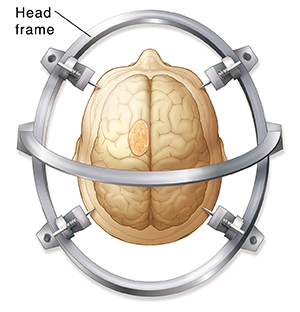Biopsy for a Brain Tumor
Biopsy for a Brain Tumor

Stereotactic biopsy
This type of biopsy is often used if a tumor is in a part of the brain that is hard to reach or near a vital area. A special frame may be put on your head to hold it still. The biopsy is guided by a computed tomography (CT) scan. Or it may be guided by a magnetic resonance imaging (MRI) scan.
Before the procedure
A few days before the procedure, you will have an exam, meet with your surgeon, and sign consent forms. You will learn if you can take your usual medicines before the biopsy. You may be told to not eat or drink for at least 8 hours some time before the test. Before the biopsy, the hair over the area where the biopsy will be taken may be trimmed. You may be asleep under general anesthesia or stay awake during the biopsy. If a frame will be used, you will have anesthesia to numb the part of your head where the surgeon will place the frame.
During the procedure
During the biopsy, a small hole will be drilled in the skull. The surgeon will pass a hollow needle through the hole and into the tumor. Cells taken from the tumor will then be sent to a lab to be examined.
Risks and possible complications of stereotactic biopsy include:
Bleeding
Seizures
Infection
Open biopsy
An open biopsy is done through an opening in the skull (craniotomy). In some cases, craniotomy is done after a stereotactic biopsy. You will likely be asleep or sedated for this procedure. A craniotomy allows an open biopsy to be done and as much of the tumor as possible to be removed. During the procedure, the scalp is cut and a piece of skull bone is taken out. This lets the healthcare provider access the brain. In most cases, the bone is put back in place after the biopsy. Often an early diagnosis is made while you are still in the operating room. This is so the neurosurgeon knows how much surgery will need to be done.
Before the procedure
A few days before the procedure, you will have an exam, meet with your surgeon, and sign consent forms. You will learn if you can take your usual medicines before the biopsy. You may be told to not eat or drink for at least 8 hours some time before the test. Before the biopsy, the hair over the area where the biopsy will be taken may be trimmed. You may be asleep under general anesthesia or stay awake for part of the procedure. You will have anesthesia to numb the part of your head where the surgeon will be operating.
Planning the return home
As with any surgery, you may need some help when you return home. Plan ahead. Have people in mind to:
Drive you home from the hospital and to appointments
Keep track of the healthcare team's instructions
Cook and take care of your house
Help take care of you
Updated:
October 21, 2017
Sources:
Clinical manifestations and initial surgical approach to patients with high-grade gliomas, UpToDate
Reviewed By:
Alteri, Rick, MD,Image reviewed by StayWell medical illustration team.,Jasmin, Luc, MD